Apart from the first, the illustrations here are all on our own website. You may use them without prior permission for any scholarly or educational purpose as long as you (1) credit the photographer or the National Army Museum, as appropriate, and (2) mention this site. [Click on them to enlarge them and usually for more information about them.]
The Dethronement of the Last Mughal King
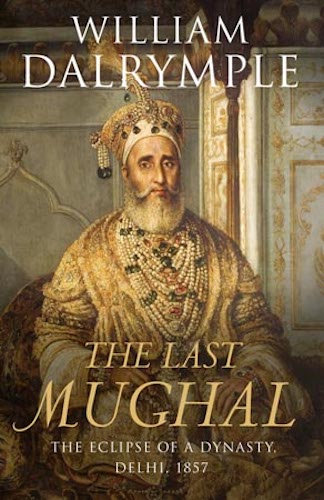
The great Mughal dynasty in India met an ignominious end, and William Dalrymple renders it dramatically in the book under review. In outline, the story is familiar. After the death of Emperor Aurangzeb in 1707, the Mughal dynasty fell into disarray. Most of the Muslim population continued to show obedience to the Emperor in Delhi, but the Marathas and the Sikhs — and the British of the East India Company — took the opportunity to try to increase their power. In this, the British proved the most successful. The reigning Emperor from 1837 was Bahadur Shah II, a poet better known by his pen-name Zafar. He was to be the last Mughal Emperor in India, whom Queen Victoria would succeed as the Empress of India.

Zafar's favourite wife, Zinat Mahal, c.1839. Courtesy of the National Army Museum, London.
But Dalrymple does more than simply bring this extraordinary story to life. Having "immersed himself in the inner courtyards of the Mughal Court" (xxvii) for several years, he presents the events of 1857 from both sides. The result is a unique rebalancing act, which shifts our sympathy as well as corecting our understanding. From the start, Dalrymple makes it clear that the empire had lost its lustre, and that Zafar was Emperor in name only. By the early 1830s, most of India was already under the control of the British East India Company. While technically operating under the auspices of the Emperor, the British Resident in Delhi, Sir Thomas Metcalfe, was in fact acting on the Company's account, and he was no longer prepared to make any secret of it. Dalrymple quotes to devastating effect from Metcalfe's letter of April 1832 to Lord Bentinck, the Governor General in Calcutta: "I think it is our best policy in future to let him sink into insignificance instead of upholding his dignity as we have done" (39). Zafar's impotence was confirmed when the British interfered in the problem of succession. Zafar's favourite wife was Zinat Mahal. She earnestly wished her only son Mirza Jawan Bakht, the fifteenth son of Zafar, to ascend the throne after her husband died. When the British intervened on behalf of the eldest son's rights instead, Zafar was forced to give way. Never much interested in his kingly duties and obligations, and certainly not a rebel by nature, he turned for solace to his usual pastimes — poetry, music and the arts.
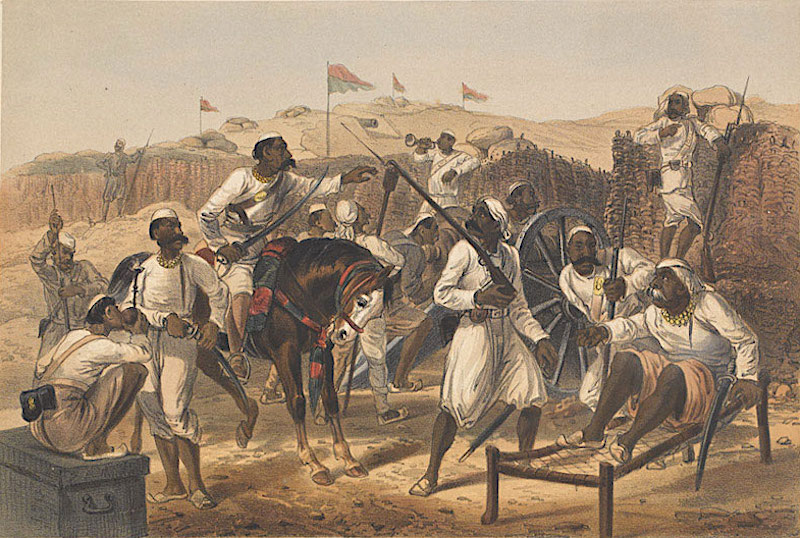
Mutinous Sepoys, c.1857. Courtesy of the National Army Museum, London.
When trouble started in Meerut on 10 May 1857, Zafar, far from having promoted it, was at the Red Fort, his palace in Delhi. On the eleventh, which was the sixteenth day of the festival of Ramadan when Muslims pray and fast throughout the day, he noticed smoke on the horizon. His emissaries reported back to him that Indian sepoys were approaching the city. In open rebellion, they had declared that they and their brothers “would no longer serve the Company” (145). Zafar's informants relayed the information usually cited as the trigger for the uprising: that the English officers had asked their troops in Meerut (as Zafar himself recorded it later) “to bite bullets with [their] teeth that were coated with the fat of cows and pigs. This [had] corrupted the faith of Hindus and Muslims alike” (146). Many of these sepoys had originally joined the British army mainly for a steady income, home and food. But now, angered by this violation of their spiritual beliefs, they turned not only against the British but those of their fellow countrymen who had converted to Christianity. When they burst into Delhi now, one of their victims was the well-respected Dr. Chaman Lal, who had come out of his hospital on hearing the disturbance. When challenged about his religion, Lal replied that he was a Christian, and a soldier “shot him dead at point blank range with his pistol” (153).
At this stage, far from supporting it, Zafar had severe misgivings about the rebellion. In the first place, he felt that it was doomed. After all, the mutineers had a chaotic and officerless army of unpaid peasant soldiers, who were set against the forces of of the world's greatest military power — albeit one that had lost many of its Indian recruits to the new Bengal Army. Nevertheless, there was widespread celebration in Delhi, with fireworks, announcing the return of Mughal power. Despite his doubts, Zafar found himself made the nominal leader of the uprising. In view of his Mughal lineage, this was hardly surprising. But the Indian soldiers who now approached their Emperor for leadership were met by an elderly man, all too aware of his powerlessness. He told them, “I have neither troops, magazine or treasury. I am not in a condition to join anyone.” To this the soldiers replied, “Only give us your blessing. We will provide everything else” (173). Almost instinctively, they gathered around him in his role of King Bahadur Shah II: he was “hailed again throughout Hindustan as the Mightiest King of Kings, Emperor son of Emperor, Sultan son of Sultan” (215).
Initially, a cavalryman at the Red Fort's Lahore Gate had explained the position "coolly" (145). But now their blood was up: they slaughtered Europeans whenever and wherever they could find them. Soon, Delhi was “almost completely emptied of the British, who had dominated it since the British defeated the Marathas in 1803” (190). Naturally, the rebels became more confident. But Bahadur Shah was uneasy. He was distressed by the looting and mayhem not only in Delhi but elsewhere too. To counter this, he endeavoured to bring back at least some semblance of order. For this reason, rather than for his own aggrandisement, he now thought it best for his people to believe that the “country had reverted to the possession of the King” (211). The sepoys were aroused by nationalistic feelings, and many of them pledged loyalty to the Emperor as "God's representative on earth" (262).
The British, with the remainder of their troops, gathered and encamped on the Ridge to the north of Delhi. Their siege would drag on not just for weeks, but months. It was, as Dalrymple points out, a very strange situation, with many sepoys of different faiths and backgrounds on both sides. Inside the city, for instance, the huge number of those who had now deserted the Company were joined by three or four thousand armed civilians, as well as “freelance Jihadis" (264). Originally, Hindus and Muslims had set aside their native differences: emphasis was laid on Hindu-Muslim unity. They were “brethren to each other” whose aim was to “butcher the English” (267). But religious rivalry was not so easily forgotten: soldiers of the different faiths started to fight among themselves, and tensions came to the boil when “Hindu sepoys cut the throats of five Muslim butchers they accused of cow killing” (295). This led to more in-fighting. But the central target here remained: to remove the British and restore the Mughal dynasty. Far from being gratified by this, Dalrymple reveals, Zafar became "more depressed, and emotionally detached from the Uprising" (297). He strongly suspected that the violence would lead to the destruction of Delhi and the final fall of the Mughals, and watched impotently, feeling that “everything he had planned and worked for -– the cultured civilized oasis as he had built” (299) was under threat. This made him long to devote his life to prayers and possibly to go on a Haj.
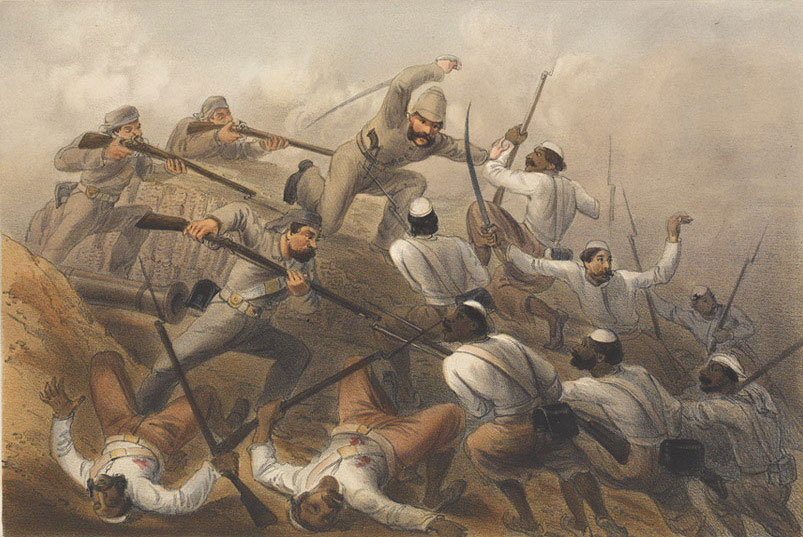
Repulse of the Rebel Sortie on Delhi Ridge, 1857. Courtesy of the National Army Museum, London.
On their part, the English made it clear that no negotiations would be entertained. From Calcutta, the Governor-General, Lord Canning, directed that “on no account should Zafar be allowed to think that he would be permitted to keep his old title or position once the rebellion was crushed” (302). And crushed it would be. To counteract the rebels, Dalrymple explains, the British formed what they called a Moveable Column which they hoped would terrorise not just Delhi but the whole of the region Punjab into submission.
The once celebrated heroes among the British come off poorly in Dalrymple's closely researched and multi-dimensional account of the campaign. One was the particularly bloodthirsty leader of the Column, John Nicholson, who had always "loathed India with passion ('I dislike India and its inhabitants more every day') and regarded only the Afghans as worse ('the most vicious and blood thirsty race in existence'” (199). Nicholson, like several other British officers of the time, was not a professional soldier. He had no military background, and had come to India as a “writer” or clerk, bringing with the Bible given to him by his Irish Protestant mother. His professed aim was to “spread the Christian Empire of the British in this heathen wilderness” (199). He and his fellow officer William Hodson, whose father had been Archdeacon of Lichfield Cathedral, proved to be particularly ruthless now; but Nicholson, whom Dalrymple labels an "imperial psychopath" was the more vicious of the two (307). These men would indeed "bring the full weight of British vengefulness to the very gates of Bahadur Shah's newly independent Mughal Delhi” (207).

Sir Thomas Brock's 1906 statue of Nicholson, now at his old school in N. Ireland.
The drama could not have been more intense, and Dalrymple does it full justice, with first-hand accounts from a whole range of sources. Nicholson arrived on the Ridge on 14 August. just over three months since the mutineers took over the city. After breaking in, his men attacked Zafar's own troops. Flourishing his sword, Nicholson led the way against them. As he did so, “a sepoy sniper, probably on the Burn Bastion [a defence post on the city wall], fired down on him. The ball entered Nicholson's chest, just below the exposed armpit. One of the other fusiliers who had belatedly come up, pointed out that he had been hit. 'Yes, yes,' replied Nicholson irritably before sinking on the ground” (353). Even then, he was scarcely vanquished. When General Archdale Wilson was reported to have lost his nerve and wanted to retreat, the dying Nicholson got to hear of it in the field hospital. Preparing to take out his pistol, he “roared ... 'I still have the strength yet to shoot him, if necessary'” (357). Nicholson lingered on long enough to hear that the British had succeeded in taking Delhi.
The aim of the British now was to arrest the Mughal King who was so revered by the Muslim mutineers in particular. They continued to profess their loyalty to him, and “begged Zafar to lead them into battle" and help them "expel the British” (366). But Zafar had no stomach for that. He retired to the Red Fort on the pretext of going for his evening prayers, but then, as night turned to day, he quietly took himself off “down the Yamuna, probably to the jetty at the Old Fort, the Purana Quila, from where he made his way to the great Sufi shrine of Nizamuddin” (369). In despair, he said that “there is not a shadow of doubt left that of the great House of Timur, I am the last to be seated on the throne of India” (370). Then, turned back from further flight by a false report originating with Hodson, he decided "to wait and pray” at the beautiful ancestral Humayun tomb nearby (372).
Dalrymple brings these historical events to life with great vigor and a plethora of telling details, from personal memoirs, correspondence and other records. As hordes of people began to flee down the Karnal and Meerut roads, the British troops stormed the Red Fort. They “poured into the inner courtyard, running down the cloister arcades searching for the royal family, who they believed were still there” (383). Victory now in their grasp, they proclaimed that “the widespread rebellion of [the] mutinous Bengal army has received a complete defeat in Upper India. The days of [Sir Robert] Clive and [General Gerard] Lake are again revived among us” (384). Eventually, as his appointed guard, Lieutenant Kendall Coghill (a man of the same temperament as Nicholson) wrote to his brother, “I had the satisfaction of receiving the 'King of Hindoostan' as a prisoner” (395). As for the British, they now had the satisfaction of having captured the figure whom they saw as “the spider at the centre of the web” of all the recent events (392).
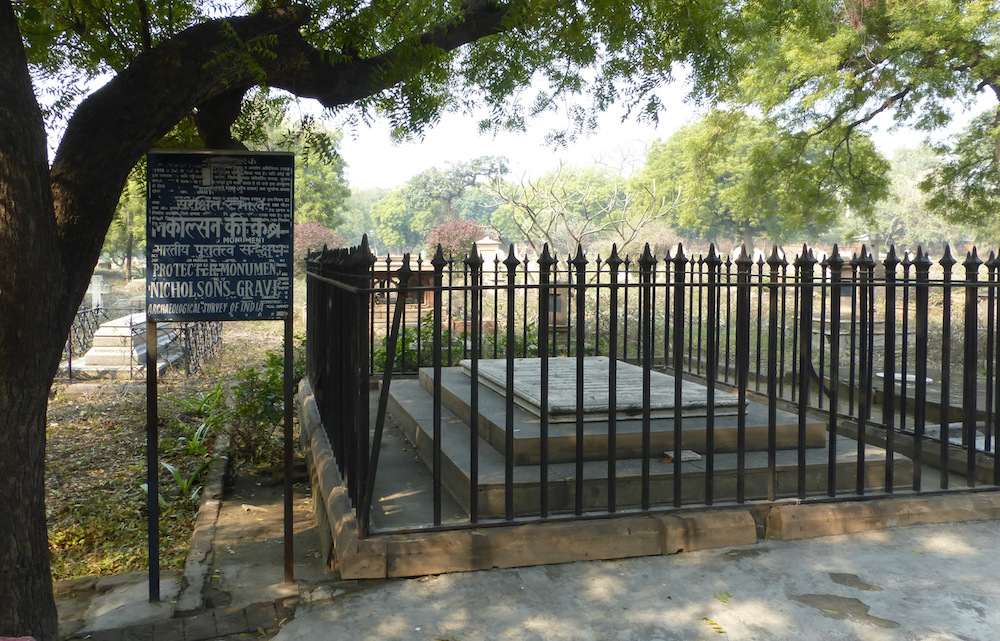
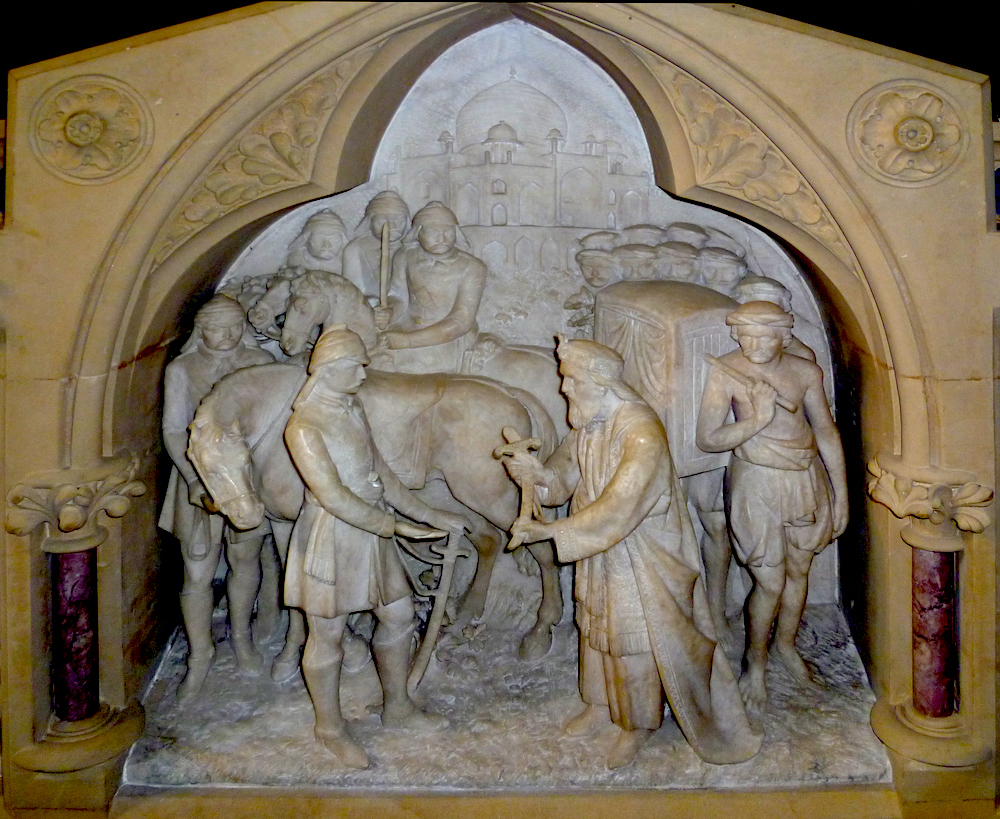
Right: Nicholson's grave in Nicholson Cemetery, Old Delhi. Left: Zafar's surrender, marble relief on Hodson's tomb in Lichfield Cathedral. Photos by Jacqueline Banerjee.
Dalrymple, as an historian, has already cast considerable doubt on this view of Zafar's role. Now he questions the legality of the aged king's arrest. When The Times sent its veteran correspondent William Howard Russell to India so that he could report on the situation, he was taken aback when he met Zafar. The absurdity of the Company's charges against the ailing prisoner was brought home to him when he walked into the cell and found the dethroned King in a miserable state. He was sick, and his bent body was “nearly prostrate over a brass basin, into which he was retching violently” (433). Russell knew Zafar's history, and on the way to seeing him was much impressed by the magnificent "mural aspect" of the Red Fort. He could not help feeling “skeptical about the legality of the Company's charges against Zafar” (434). He had neither instigated the rebellion, nor could he really be blamed for, in Russell's own words, "wanting to throw off his bondage” (435). The old Emperor himself had committed no crime.
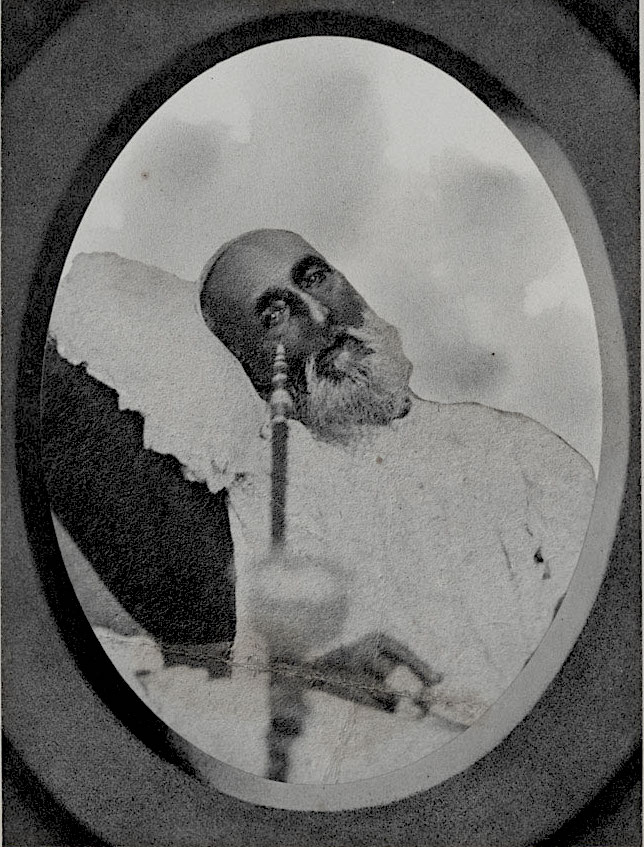
Zafar in 1859. Courtesy of the National Army Museum, London.
However, the manipulative British had put him on the “wanted” list, and now arbitrarily put him on trial. Bahadur Shah saw the trick and told the Court that he had nether the desire nor the inclination to defend himself. He pleaded ignorance of the language that was being used in the Court. He said that he had no connection with the uprising, but “had all along been the helpless prisoner of the sepoys” (438). The prosecutor Major Harriot did not need any time to formulate his judgment. He arbitrarily announced that the King's intention was "to subvert the British Empire and put the Mughals in its place” (438) — an extraordinary charge, considering not only the events themselves, but the fact that the trial began on 27 January 1858 (543, n.126), and the Government of India Act, transferring the East India Company's powers to the government) was not passed until 2 August that year. The trial dragged on for weeks, often interrupted by the ailing King's physical condition. Finally the Court came to deliver its judgment in 9 March, unanimously finding Zafar guilty "of all and every part of the charges preferred against him” (443).
It did not sentence him to death — ostensibly because of a guarantee originally given, but obviously for fear of political upheavals. Instead he was transported to Burma, along with his wife Zinat, his youngest son Mirza Jawan Bakht, and various other relatives who followed him into exile. Hodson had killed three of the other princes (two sons and a grandson) in cold blood after their surrender. Most of the rest were apprehended and killed elsewhere in Delhi, though two escaped to live elsewhere in obscurity. There was to be no new figurehead to attract Indian loyalties. When Zafar finally died in 1862, at the age of 87, the British Commissioner for Burma wrote to London, “None of the family appear much affected by the death of the bed-ridden old man. His death was evidently due to pure decrepitude and paralysis in the region of the throat” (1-2). Zinat outlived him to die in 1882. Mirza Jawan Bakht died in exile too, in his early forties, in 1884. Thus ended the Great Mughal Empire in India, after more than three centuries of rule. Dalrymple's thoroughly researched account leaves us with new and disturbing ways of looking at a dramatic episode in Indo-British relations, which had enormous consequences for not only India but the whole world.
In a work of this scope, the "Dramatis Personae" and the maps at the beginning are especially helpful. Numerous illustrations, often in colour, add another dimension to the narrative, and the glossary, copious notes, and comprehensive bibliography are all valuable additions.
Related Material
- The Epic of the Race: The Indian Uprisings of 1857
- Representations of the Indian Mutiny in Higher Victorian Journalism
- Review of Stuart Flinders' Cult of a Dark Hero: Nicholson of Delhi
Bibliography
Dalrymple, William. The Last Mughal: The Fall of a Dynasty in Delhi, 1857. Delhi: Penguin, 2007. 578 + xxvii pp. ISBN 978-0-143-10243-4. 599 Rupees.
Created 26 May 2020